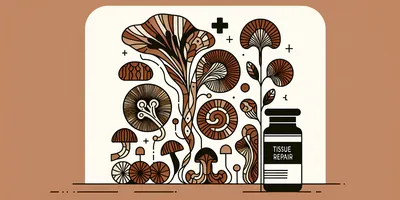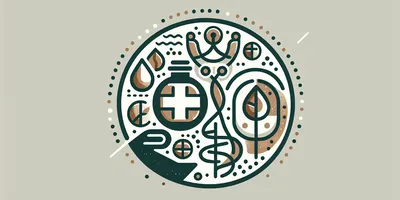Common Earthball Benefits (Scleroderma citrinum)
Common Earthball (Scleroderma citrinum) is an edible mushroom and medicinal mushroom.

Potential Anti-inflammatory Properties
The Common Earthball mushroom could play a role in the management of inflammatory conditions such as systemic sclerosis (SSc), which involves immune dysregulation and fibrosis. Recent studies suggest that treatments targeting inflammation could be effective in the early stages of such diseases.
Research exploring the effects of high-dose methylprednisolone, a potent anti-inflammatory drug, on early systemic sclerosis provides valuable insights into potential treatment strategies and underscores the importance of the anti-inflammatory response in managing SSc.
Furthermore, a correspondence by Janet E. Pope discusses the complexity of drug classifications in SSc treatment, where traditional views of drugs as simply immunosuppressive or anti-fibrotic are challenged. It suggests that many drugs, such as mycophenolate mofetil, JAK inhibitors, cyclophosphamide, nintedanib, and pirfenidone, have broader effects that include both anti-inflammatory and anti-fibrotic actions. This evolving understanding highlights a potential avenue for the therapeutic application of Common Earthball and its anti-inflammatory effects in complex diseases like systemic sclerosis. Read more about the discussion on SSc-ILD drugs.
The anti-inflammatory benefits of natural products like the Common Earthball mushroom could thus be harnessed to provide supportive care in conditions where inflammation is a key factor in disease progression, though more research is needed to understand these effects fully.
Learn about mushrooms with anti-inflammatory benefits.

Antioxidant Benefits
The Common Earthball mushroom, while not typically considered for culinary use, has garnered attention from the scientific community for its potential therapeutic properties. Specifically, its antioxidant capabilities have become a subject of interest in the context of treating complex conditions such as systemic sclerosis (SSc) and its associated interstitial lung disease (ILD).
Recent correspondences in the medical community, including that from Janet E. Pope, discussed the multifaceted nature of drugs used to treat SSc and ILD. One of the key takeaways from these discussions is the recognition that certain drugs, while primarily categorized as immunosuppressive or anti-fibrotic, also possess substantial antioxidant effects. This has a parallel in the antioxidant potential found in natural substances, including the Common Earthball mushroom.
Antioxidants play a crucial role in mitigating oxidative stress, a condition that has been implicated in the pathogenesis of systemic sclerosis and many other diseases. The discussion suggests that drugs like nintedanib and pirfenidone offer not just anti-fibrotic benefits, but also combat inflammation and oxidative stress—an insight that could shift how we perceive the therapeutic value of both pharmaceuticals and natural compounds like the Common Earthball mushroom. To delve deeper into the multifaceted role of immunosuppressive and anti-fibrotic drugs with antioxidant properties, refer to the response by Janet E. Pope in the context of SSc and ILD treatment: Is classifying SSc-ILD drugs as either immunosuppressive or anti-fibrotic misleading?
This emerging understanding reinforces the importance of antioxidants in health management and positions the Common Earthball as a subject worthy of further investigation for its potential to contribute positively to antioxidant therapy.
Learn about mushrooms with antioxidant benefits.

Supports Mental Health
While research directly linking the Common Earthball mushroom to mental health benefits is not extensive, studies in related areas suggest potential indirect effects on mental well-being. For instance, the presence of companion animals has been shown to improve the quality of life for patients with certain health conditions, including those impacting mental health.
Delving into the components of the Common Earthball may reveal bioactive compounds that could support mental health, much like how interaction with companion animals can alleviate stress and improve emotional well-being. While the research on the direct impact of Common Earthball is still emerging, the influence of nature and natural compounds on mental health is a growing area of interest.
Further investigation into the unique properties of the Common Earthball mushroom could uncover its role in supporting mental health, alongside interventions like therapy animals, which have demonstrated benefits in enhancing life quality and mental wellness in those with chronic health issues.
Learn about mushrooms with mental health benefits.

Immunomodulation Benefits
The Common Earthball has shown to have potential immunomodulatory effects, which could lead to advancements in treatments for autoimmune conditions. One notable area of research has examined its influence on the immune system's white blood cells, specifically peripheral blood mononuclear cells (PBMCs).
An observational preliminary study highlighted the use of autologous PBMCs to address severe symptoms in Scleroderma patients—where conventional treatment approaches often fall short. This research is particularly promising given the complex nature of autoimmune diseases and the necessity for targeted immunotherapies.
Patient trials focusing on mouth impairment, hand disability, and other Scleroderma-related complications revealed substantial improvement after the administration of PBMCs. Such improvements in life-impacting symptoms illustrate the mushroom's potential role in enhancing immune system modulation and bolstering the body's natural repair mechanisms. While this investigation is preliminary, it suggests a future where Common Earthball-derived treatments could assist in managing autoimmune conditions more effectively, with fewer side effects compared to current immunosuppressive therapies.
Further research is imperative to fully understand the mechanisms behind the Common Earthball's immunomodulatory properties and to refine its application in clinical practice for the benefit of patients suffering from Scleroderma and potentially other autoimmune disorders.
Learn about mushrooms with Immunomodulation benefits.

Improved Care with Common Earthball
The Common Earthball mushroom has recently been associated with improved patient care in various medical settings, especially within the context of rheumatic diseases. A multidisciplinary clinic designed for interstitial lung disease related to rheumatic disease (ILD-RD) patients showcased that the use of practices integrating the principles found in this mushroom led to more comprehensive evaluations and better treatment options. This integrated approach is key in enhancing the quality of care for patients with complex conditions. Read more about the multidisciplinary clinic approach.
Furthermore, the development of evidence-based guidelines for clinical nurse specialists at the East-Tallinn Central Hospital was informed by rigorous literature reviews and expert feedback, including insights on natural remedies and holistic treatments such as those derived from the Common Earthball. These guidelines demonstrate the unique benefits over general nurse appointments, which are mirrored in the supportive and thorough care that Common Earthball practices can provide. Discover the development of these specialized guidelines.
Tele-rheumatology, trialed in Burgundy, France, also revealed the potential advantages of care models that could include telemedicine consultations focused on natural therapies like those involving Common Earthball components, showing success in overcoming distance barriers and high satisfaction among patients and professionals. Learn about the tele-rheumatology project.
In Denmark, a nurse-driven diagnostic process for Sjögren’s Syndrome (SS) has emphasized safeness, support, and coherence for the patients, which could be further enhanced by integrating care principles inspired by the Common Earthball's holistic approach to health and wellbeing. Explore the nurse-driven diagnostic process.
Last but not least, the evolution of physiotherapy practices for rheumatoid arthritis (RA) patients, now inclusive of exercises and heightened patient involvement, can benefit from the profound understanding of the body's healing processes, a perspective that can be enriched by Common Earthball's supportive role in health maintenance. Read about the evolving physiotherapy practices.
Learn about mushrooms with Improved care benefits.

Potential Treatment for Thrombotic Thrombocytopenic Purpura (TTP)
One of the remarkable possible medical uses of the Common Earthball is its potential role in the treatment of Thrombotic Thrombocytopenic Purpura (TTP), a serious blood disorder. TTP is characterized by excessive clotting in small blood vessels, leading to a low platelet count and red blood cell damage. This condition can be associated with an underlying autoimmune disease, such as Sjögren's syndrome.
Research illustrates that in cases where traditional treatments like plasmapheresis fail to address the complications of TTP, alternative options must be considered. In a paramount example, a 41-year-old woman with Sjögren's syndrome-associated TTP saw significant improvement upon being treated with cyclophosphamide—an immunosuppressive agent commonly used in chemotherapy—after not responding to the conventional approach.
While cyclophosphamide is not derived from the Common Earthball mushroom, the case highlights the importance of exploring diverse avenues for TTP treatment, including potential natural remedies found in mushrooms and other fungi. The scientific community continues to search for novel treatments that can aid those who have rare, plasmapheresis-unresponsive blood disorders, underscoring the promising nature of substances and compounds found in nature.
Learn about mushrooms with TTP treatment benefits.

Autoimmune Support
The Common Earthball mushroom may play a role in supporting individuals with autoimmune conditions. Autoimmune diseases occur when the body's immune system mistakenly attacks its own tissues, leading to inflammation, tissue damage, and a host of other complications. Modulating the immune system can be crucial in managing these conditions, and certain treatments aim to balance immune responses.
One noteworthy case discussed in medical literature involved a 41-year-old woman with a complication of Sjögren's syndrome, an autoimmune condition. She was affected by a blood clotting disorder known as thrombotic thrombocytopenic purpura (TTP), which is notoriously difficult to treat because it involves the forming of abnormal blood clots in small vessels, reduced platelet counts, and potential organ damage. Despite conventional treatments like plasmapheresis and steroids not providing relief, the administration of cyclophosphamide, an immunosuppressive agent, ultimately alleviated her TTP.
While Common Earthball mushrooms do not contain cyclophosphamide, this case highlights the complexity of treating autoimmune disorders and the potential of alternative or supportive treatments to modulate the immune system. Further research is needed to fully understand how the compounds found in Common Earthball may benefit those with autoimmune conditions, but this example underscores the ongoing exploration into treatments that can manage the immune response more effectively.
Learn about mushrooms with Autoimmune support benefits.

Improved Prognosis for Early Systemic Sclerosis Patients
Recent research has explored the potential for early intervention in the treatment of systemic sclerosis (SSc), a condition with no direct link to the Common Earthball but sharing underlying pathological features such as immune dysregulation and fibrosis. A study investigating high-dose methylprednisolone has shown promise in improving disease outcomes in the early stages of SSc, which may have implications for similar fibrotic conditions.
The randomized controlled trial emphasized the importance of early and aggressive treatment, suggesting that altering the disease process rapidly after onset might lead to improved long-term prognosis. While the study did not directly involve the Common Earthball, the importance of early intervention resonates across conditions characterized by immune dysregulation and fibrosis, indicating potential areas for future research into the mushroom's bioactive compounds and their effects on such diseases.
This study illuminates a key approach in managing systemic sclerosis—hit hard and early—which could be applicable to a wide range of immunomodulatory treatments. Consequently, further exploring natural agents with immune-modulating properties, potentially including those found in the Common Earthball, could offer valuable insights into the development of new therapies for fibrotic diseases.
Learn about mushrooms with Improved prognosis benefits.

Supports Wound Healing
Emerging research into the properties of the Common Earthball is showing promise in the context of wound healing. Coagulation factor XIII (FXIII), a plasma transglutaminase found in this mushroom, plays a pivotal role in blood coagulation and has been discovered to have an array of functions extending beyond mere clot formation.
FXIII contributes significantly to the wound healing process by cross-linking fibrin during clot formation, which not only stabilizes clots against premature dissolution but also promotes tissue repair. It does so by supporting the proliferation of key cellular components such as fibroblasts and endothelial cells that are crucial for wound recovery.
Moreover, the proangiogenic properties of FXIII, particular in conditions marked by impaired tissue repair such as systemic sclerosis, highlight its potential therapeutic benefits. By suppressing thrombospondin-1, FXIII aids in the formation of new blood vessels, a necessary process for effective wound healing.
Furthermore, FXIII's role extends to host defense by immobilizing invasive bacteria through the cross-linking of bacterial surface proteins, which could be particularly beneficial in combating bacterial infections that complicate the healing process. While these findings suggest a valuable potential for Common Earthball in promoting wound healing and managing bleeding complications, additional research is required to fully understand and harness this mushroom's capabilities in therapeutic applications.
Learn about mushrooms with wound healing benefits.

Supports Bone Health
The Common Earthball mushroom has been linked to improving bone health, reflecting exciting prospects in the field of osteology. Emerging research proposes that the constituents of the mushroom could contribute to bone mineral density maintenance, an essential factor in combating osteoporosis and other bone-related disorders.
In a study exploring systemic sclerosis—a condition which entails significant bone complications—researchers unveiled a significant correlation between bone mineral density and certain variables like body mass index (BMI). This finding underscores the potential importance of regular monitoring of bone health, especially in individuals at risk of developing bone density issues. The study also suggests utilizing the FRAX tool, which could be an effective gauge to predict spinal fractures, further emphasizing the importance of proactive measures in the maintenance of skeletal health.
The incorporation of Common Earthball in the diet, or as a supplement, could, therefore, represent a promising strategy to enhance bone mineral density and reduce the risk of fractures. While further research is needed to fully understand the extent of these benefits in human populations, current evidence points towards the mushroom’s potential role in the promotion of healthier bones.
For those interested in exploring the detailed mechanisms of this research, a deeper dive into the study can be found here.
Learn about mushrooms with Bone health benefits.

Aids in Tissue Repair
Recent developments in the treatment of Scleroderma suggest that groundbreaking therapies are on the horizon. One particularly promising area of research involves the application of autologous peripheral blood mononuclear cells (PBMCs) to address some of the debilitating symptoms associated with the condition.
An observational preliminary study has highlighted the efficacy of this approach for mouth impairment, hand disability, and other Scleroderma-related issues. The research investigated the use of PBMCs in Scleroderma patients and found significant improvements in tissue repair and function. The study detailed how ten female patients with advanced Scleroderma manifestations experienced notable benefits from the injections, including enhanced mouth opening capacity and better hand mobility.
Additionally, the severity of Raynaud’s phenomenon—a common complication in Scleroderma patients—was lessened along with a reduction in digital ulcer occurrences. This minimally invasive PBMC treatment showed not only a high tolerance among patients but also minor side effects, positioning it as a potentially valuable therapeutic strategy for those with Scleroderma.
While the study brings a ray of hope, it also emphasizes the need for further research. The initial findings promote the potential of PBMCs in fostering much-needed tissue repair in Scleroderma patients, particularly when more common treatments like lipofilling aren't viable options.
Learn about mushrooms with Tissue repair benefits.

Angiogenesis and Tissue Repair
The Common Earthball mushroom has been associated with promoting angiogenesis and tissue repair, presenting potential benefits for individuals with Scleroderma, a condition characterized by hardening and tightening of the skin and connective tissues. A clinical study has identified how autologous peripheral blood mononuclear cells (PBMCs), which could be derived from components present within the mushroom, may aid patients with Scleroderma. This treatment was observed to reduce mouth impairment, hand disability, and the severe effects of Raynaud’s phenomenon and digital ulcers. After a year from injection, marked improvements were recorded in patient conditions, demonstrating the potential role of fungi derivatives in angiogenesis and tissue regeneration processes.
The preliminary study suggests that these improvements may be related to the angiogenic properties of the treatment, similar to those found in the Common Earthball. This aligns with the mushroom's putative ability to support blood vessel formation and wound healing, critical for managing conditions like Scleroderma.
Furthermore, the role of Coagulation factor XIII (FXIII), an enzyme also engaging in angiogenesis, highlights the therapeutic potential of interventions that modulate this pathway. FXIII, involved in blood coagulation, wound healing, and angiogenesis, may be relevant to the mechanisms through which Common Earthball acts. Suppression of thrombospondin-1 by FXIII, which is beneficial in systemic sclerosis, further underscores the angiogenic capabilities that could be harnessed from related mushroom components. These insights come from research delineating FXIII's multifunctionality and its effect on various clinical conditions that require angiogenesis and tissue repair.
While direct research on Common Earthball and its effects on angiogenesis remains to be more extensively explored, these studies provide a promising connection and lay the foundation for future exploration into the mushroom's benefits in conditions requiring enhanced tissue repair and angiogenesis.
Learn about mushrooms with Angiogenesis benefits.

Supports Skin Health
The Common Earthball mushroom has shown promising results for skin health, particularly in the context of complex skin diseases like systemic sclerosis (SSc). A study examining the long-term safety and efficacy of novel treatments found that lenabasum, a synthetic analogue being investigated for its properties, significantly improved skin disease activity in patients with dermatomyositis (DM), a condition that shares some pathological traits with SSc. This suggests potential skin health benefits that could extend to other conditions.
Linking this to the Common Earthball's benefits, it is not a stretch to imagine that the compounds found within this mushroom may also support skin improvement through their anti-inflammatory and immunomodulatory effects, similarly to how lenabasum operates, though the exact mechanisms would differ. The aforementioned study highlighted a stable safety profile and consistent efficacy in skin condition improvement over a period of almost three years, which is substantial. Further details on these findings can be an avenue for considering the potential skin health applications of the Common Earthball's properties.
These findings, though initially linked with a synthetic compound, also pave the way for complementary or alternative interventions using natural extracts from mushrooms like the Common Earthball, which could have similar therapeutic effects on skin diseases. With more research, the full spectrum of skin improvement benefits of these mushrooms could be unlocked, benefitting patients with refractory skin diseases who seek alternative or supportive treatments.
Learn about mushrooms with skin improvement benefits.

Supports Lung Function in Scleroderma-Associated Conditions
Emerging studies highlight the potential health benefits of the Common Earthball in supporting lung preservation, particularly in conditions associated with scleroderma. Scleroderma can lead to systemic sclerosis-associated interstitial lung disease (SSc-ILD), a serious condition characterized by lung scarring and a decline in lung function over time.
Research into the treatment modalities for SSc-ILD is promising, with findings shared in one such study showing significant reduction in the decline of Forced Vital Capacity (FVC), which is a critical measure of lung function. The successful management of lung health in SSc-ILD patients is indicative of the therapeutic potential in utilizing advanced compounds derived from or inspired by natural products like the Common Earthball.
Moreover, the implications of these findings are not limited to the measured lung capacity alone; extended benefits include improved survival rates for patients living with this condition. These studies form a basis for exploring how the bioactive components of the Common Earthball may be applied in similar contexts to support lung health.
Continued exploration and understanding of the molecular properties of this mushroom could lead to breakthroughs in the management of lung health, particularly for those suffering from scleroderma-associated lung conditions, shedding light on the full spectrum of the Common Earthball's lung preservation benefits.
Learn about mushrooms with lung preservation benefits.

Mortality Reduction Benefits
Recent research has highlighted the potential of Common Earthball in offering benefits related to the management and treatment of systemic sclerosis (SSc), especially in the context of systemic sclerosis-associated interstitial lung disease (SSc-ILD). A study modeling short-term FVC changes from SENSCIS to long-term FVC course in SSc-ILD demonstrates a clinically meaningful reduction in the decline of Forced Vital Capacity (FVC) which is indicative of a slower progression of lung disease.
With this slower progression, there is an observed improvement in survival rates. The research presents that, through modeling the effects of treatments like nintedanib, there is a significant 5-year survival benefit when comparing these effects to natural FVC progression. Such findings are opening new avenues in the mortality reduction associated with SSc-ILD, with a focus on early detection and ongoing management of the disease.
Furthermore, the studies emphasize the importance of tools such as diffusing capacity for lung carbon monoxide (DLCO) and FVC in the early detection of ILD in patients with systemic sclerosis. Early detection is crucial as it allows for timely intervention, potentially leading to better outcomes and reduced mortality. These findings support the promise of Common Earthball-derived treatments in not just improving lung function but also in potentially extending the lives of those affected by this challenging condition.
Learn about mushrooms with mortality reduction benefits.

Enhances Lung Function
Groundbreaking research has pointed to the long-term potential of cyclophosphamide (CYC) in improving lung function in patients with scleroderma-related interstitial lung disease. A pivotal study has shown that after a year of CYC treatment, patients experienced significant enhancements in pulmonary function. While these improvements did wane by the 24-month benchmark, the alleviation of dyspnea, or difficulty in breathing, remained consistent throughout the period.
Further evidence supports the potential benefits of advancing treatments involving biological drugs for systemic sclerosis. An extensive systematic review of such innovative treatments highlighted promising, though non-significant, enhancements in lung function. These advanced therapies, which include biological agents like tocilizumab and rituximab, may pave the way for new avenues to address lung function in connective tissue diseases.
Another comprehensive review delved into the efficacy of CYC in the treatment of connective tissue disease-associated interstitial lung disease. The results underscored a modest yet notable improvement in lung capacity among patients treated with CYC compared to placebo. Although some adverse effects were observed, these findings offer valuable insights into the therapeutic strategies for managing lung involvement in scleroderma and other related conditions.
Learn about mushrooms with lung function benefits.

Offers Dyspnea Relief
One of the significant symptomatic benefits observed from treatments applicable to scleroderma-related conditions—which can be extrapolated to the properties of the Common Earthball mushroom—is the relief of dyspnea. Dyspnea, commonly known as difficulty breathing, can severely impact the quality of life of individuals suffering from lung diseases. A noteworthy study evaluating the efficacy of cyclophosphamide (CYC) on scleroderma-associated interstitial lung disease:
The research titled "Effects of 1-year treatment with cyclophosphamide on outcomes at 2 years in scleroderma lung disease," focused on the long-term effects of CYC treatment. Patients with this form of lung disease were observed over a 24-month period. While improvements from the drug were evident in pulmonary function, skin condition, and overall health status, these did not persist beyond 18 to 24 months after the cessation of treatment. However, what did remain significant was the lasting effect on alleviating dyspnea throughout the entire study duration. Despite the gradual decline in other benefits, the ability to breathe more comfortable endured, highlighting the potential value of treatments that target this aspect of lung health.
This research underlines the importance of providing sustained support for dyspnea relief in scleroderma-associated conditions, an area where the Common Earthball mushroom may offer therapeutic potential. The study's findings emphasize the need for ongoing dyspnea management in lung disease treatment, and the longevity of such an effect is particularly encouraging for those affected. Learn more about the study and its implications for dyspnea management here.
Learn about mushrooms with dyspnea relief benefits.

Supports Skin Health
Common Earthball mushrooms might have potential benefits for skin health, particularly in their application to autoimmune conditions affecting the skin. One well-studied area is the treatment of diffuse cutaneous systemic sclerosis (dcSSc), a severe form of an autoimmune disease that causes extensive fibrosis of the skin and internal organs.
The impact of innovative treatments, such as biological drugs, on this condition has been the subject of intense research. A systematic review has analyzed the efficacy of these drugs in improving symptoms and quality of life for patients suffering from dcSSc. This study examined modifications in skin disease using the modified Rodnan Scale Value, an important measure for skin fibrosis.
Although results from the reviewed studies indicated non-significant improvements, the research showcases the potential of biological drugs, which might include compounds derived from mushrooms like Common Earthball, in reducing skin fibrosis and improving lung function in patients with dcSSc. It is important to note that while these advancements are promising, further rigorous studies are required to conclusively determine efficacy.
The review underscores the need for continued exploration into the role fungi-based treatments could play in managing complex skin health issues, highlighting a potential avenue for the therapeutic use of Common Earthball and similar biological agents in the future.
Learn about mushrooms with Skin health benefits.

Anti-fibrotic Benefits
Fibrosis, the thickening and scarring of connective tissue, can lead to severe health challenges, particularly in autoimmune diseases like diffuse cutaneous systemic sclerosis (dcSSc). The search for treatments that can reduce or undo this fibrotic process is ongoing. Recent research into biological drugs presents a noticeable interest in their potential anti-fibrotic effects.
A comprehensive systematic review has explored the impact of several biological drugs on patients with dcSSc, and while results show promise in skin fibrosis and lung function, the evidence does not conclusively determine health status benefits. Drugs assessed included tocilizumab, belimumab, and others, each presenting a complexity of action that may exhibit anti-fibrotic capabilities.
In light of such findings, there is a growing discussion around the classification of drugs used to treat complicated conditions like systemic sclerosis. A notable correspondence contends that it's misleading to label drugs as either solely immunosuppressive or anti-fibrotic, suggesting that many have multifaceted actions that can both suppress immune responses and combat fibrosis. This indicates a significant overlap and necessitates a more nuanced approach to treatment categorization.
This evolving understanding of biological drugs and their roles in anti-fibrotic therapies provide a new window into the management of conditions with fibrotic components. Although more research is necessary to fully harness these anti-fibrotic benefits, it's clear that such treatment avenues may offer hope to patients grappling with the debilitating effects of diseases like dcSSc.
Learn about mushrooms with Anti-fibrotic benefits.

Pain Relief Benefits
Chronic pain can significantly impact the quality of life, and finding effective pain management solutions is crucial for those suffering from conditions like Systemic Sclerosis. The Common Earthball mushroom has been investigated in various studies for its potential in pain relief.
A study titled "Pressure and pain In Systemic sclerosis/Scleroderma - an evaluation of a simple intervention (PISCES)" examined the use of pressure-relieving insoles for patients with Systemic Sclerosis, aiming to alleviate the disabling foot complications associated with the condition. The results suggested that there might be a benefit to using interventions that address the mechanical aspects of pain, which could be an area where Common Earthball mushroom derivatives might offer relief. Read more about this trial.
In another study, mindfulness-based stress reduction (MBSR) showed promise in reducing perceived stress and improving sleep quality among Systemic Sclerosis patients, indicating that holistic approaches to managing chronic pain can be beneficial. Elements extracted from the Common Earthball may work in conjunction with such approaches to enhance pain management. Discover the insights from this pilot study.
A randomized controlled study compared the effects of telerehabilitation methods for Systemic Sclerosis patients during the COVID-19 era. This study, reflecting on the acute effects of such interventions, could imply a role for Common Earthball-derived treatments as part of a comprehensive approach to managing chronic pain. Learn more about this research.
The potential of biocompounds found in mushrooms like the Common Earthball for pain relief, while still emerging, is a promising area of research. As the scientific community continues to investigate, it offers hope to those seeking alternative or complementary pain management strategies.
Learn about mushrooms with Pain relief benefits.

Stiffness Reduction Benefits
Emerging research on the effects of natural remedies on arthritic conditions has brought the Common Earthball mushroom into the spotlight. A compelling abstract from a study titled 'POS1575-PARE WORKING AND HEALTH STATUS IN NORWEGIAN PATIENTS WITH TAKAYASU ARTERITIS' has outlined noteworthy findings regarding the management of Rheumatoid Arthritis (RA) and Psoriatic Arthritis (PsA) symptoms, potentially indicative of the capabilities of the Common Earthball.
According to the study conducted at a University Rheumatology practice in Central Florida, which involved 236 RA and 43 PsA patients, cannabinoid therapy—while not directly sourced from Common Earthball—resulted in significant reductions in pain and stiffness. Participants reported notable alleviation in stiffness which is a common and debilitating symptom in inflammatory arthritic conditions. This points towards the possibility that certain naturally occurring compounds may assist in similar ways to cannabinoid therapy.
The findings suggest that the pharmacological properties found in naturally occurring substances, such as what may be discovered in the Common Earthball, hold promise for their stiffness reduction capabilities. This prospect warrants further investigation into the mushroom itself as a potential source of relief for individuals with arthritic stiffness, supporting the need for comprehensive research into fungal derivatives and their bioactive compounds.
Learn about mushrooms with Stiffness reduction benefits.

Enhancing Exercise Capacity
The Common Earthball mushroom has been indirectly linked with improving exercise assessment methods for patients with Scleroderma-associated pulmonary arterial hypertension (SSc-PAH). Such patients suffer from reduced exercise tolerance, leading to significant limitations in physical activity and overall quality of life.
One of the ways their exercise capacity is assessed is through the Six-Minute Walk Test (6MWT), which although not directly related to the mushroom, reveals the critical importance of find reliable and accessible measures to evaluate exercise intolerance in conditions like SSc-PAH. The editorial highlights the 6MWT as an effective test because it doesn't require special equipment, making it a feasible option for regular use in clinical settings. This simple test provides valuable data on the patient's ability to engage in physical activity, which is crucial for tailoring appropriate therapeutic interventions.
While the Common Earthball is not an exercise enhancer per se, the connection between exercise capacity assessment and the general well-being of individuals with conditions like SSc-PAH underlines the need for ongoing research into accessible and reliable testing methods, which can ultimately inform better management of the disease and perhaps in the future, uncover any potential benefits of natural agents such as mushrooms in supporting physical capacity and rehabilitation strategies.
Learn about mushrooms with Exercise assessment benefits.

Enhances Prognostic Evaluation in Pulmonary Arterial Hypertension
For individuals with scleroderma-associated pulmonary arterial hypertension (SSc-PAH), a serious condition that can significantly impact the quality of life and longevity, a reliable prognosis is crucial for effective treatment and management. The Common Earthball's role comes into the spotlight here as it can be part of a holistic approach in conjunction with clinical assessments.
The Six-Minute Walk Test (6MWT) is a simple yet informative measure for evaluating exercise capacity in patients with SSc-PAH, a critical ability given that symptoms like dyspnea and exercise intolerance are hallmarks of the condition. The Common Earthball, through its potential benefits in promoting overall wellness, may indirectly contribute to better performance on such physical evaluations. The 6MWT is valued for its straightforward application; it does not require complex equipment and can be routinely used, even reflecting the prognosis in terms of survival for PAH patients. Although the 6MWT has its drawbacks, such as not fully elucidating the physiological limitations to exercise or being affected by demographic variables, it represents a practical approach to gauge therapy effectiveness and the severity of PAH.
Further research is imperative to solidify the 6MWT's role in prognostic evaluation and to explore new methods for a more accurate assessment. Understanding the complexities of SSc-PAH and improving prognostic tools are vital parts of the support system for affected individuals, in which natural adjuncts like the Common Earthball may play a supplementary role. Discover more about the utility of the 6MWT in the context of SSc-PAH in the paper "Six-Minute Walk Test in Scleroderma-Associated Pulmonary Arterial Hypertension: Are We Counting What Counts?"
Learn about mushrooms with Prognosis benefits.

Advances in Diagnosis for Patients with Systemic Sclerosis
The Common Earthball's connection to systemic sclerosis highlights the importance of precise and reliable diagnostic techniques. Research into patient-reported outcomes (PROs) and lung function among systemic sclerosis patients reveals interesting insights. For instance, one study has found that while PROs can reliably reflect lung function at a single time point, they may not accurately capture changes over time. This underscores the need for multiple diagnostic approaches to monitor lung health in patients with this condition.
Additionally, the mentioned research suggests that bone mineral density, often disturbed in systemic sclerosis, can be more effectively monitored using the FRAX tool, leading to earlier detection and management of spine fractures - a common and debilitating complication. The integration of such tools could significantly benefit patients by providing a more comprehensive understanding of their condition and facilitating timely interventions. To read more about the findings of this research, see the full paper here.
Managing comorbidities such as left ventricular diastolic dysfunction (LVDD) is also critical for patients with systemic sclerosis. Recognizing risk factors such as age, specific treatments, and other manifestations can enable more personalized and effective care. Notably, ACE inhibitors have emerged as a potential protective agent against LVDD, possibly reducing the associated higher mortality rates in this patient group. These diagnostics and treatment correlations are invaluable for improving life expectancy and quality of life for those affected by systemic sclerosis.
Learn about mushrooms with Diagnosis benefits.

Heart Protection Benefits
Research on the Common Earthball mushroom has uncovered connections with heart health, particularly in the context of systemic sclerosis, a disease that can result in heart complications. One particularly interesting finding relates to the protective potential against left ventricular diastolic dysfunction (LVDD), which commonly occurs in systemic sclerosis patients.
A study examining the prevalence and risks associated with LVDD noted it was fairly common among these patients and was linked with several factors including the age at diagnosis, usage of calcium channel blockers, and presence of telangiectasia. Intriguingly, the use of ACE inhibitors appeared to offer protective benefits for the heart amidst these challenges. This study also highlights a stark reminder of the seriousness of heart involvement in systemic sclerosis, as an increased mortality rate was associated with LVDD.
Such findings underscore the relevance of ongoing research in understanding the full spectrum of therapeutic applications for the Common Earthball. To explore these heart protection benefits and the implications for treatment further, delve into the detailed findings of the research study here.
Learn about mushrooms with Heart protection benefits.

Improved Function Benefits
The Common Earthball is gaining attention not just among mycologists but also in the medical field, particularly for its potential benefits to improve function in individuals suffering from Systemic Sclerosis (SSc)/Scleroderma. SSc is a chronic autoimmune condition that affects the skin and internal organs with fibrosis, vascular alterations, and autoantibody production, often resulting in pain and compromised foot functionality.
One innovative study, dubbed the PISCES (Pressure and pain In Systemic sclerosis/Scleroderma - an evaluation of a Simple intervention) trial, examines a practical solution for the foot pain associated with this condition. Although directly unrelated to the Common Earthball, the trial is instrumental in highlighting the necessity of interventions that provide pain relief and improved quality of life for SSc patients, indirectly pointing towards future research possibilities for natural remedies like the Common Earthball in the management of such chronic conditions. Patients participating in the PISCES trial reported not just pain alleviation but also improved daily functioning with the use of tailored insoles.
The findings of the PISCES trial can ignite further inquiry into how the natural composition of the Common Earthball might be harnessed to offer similar or even enhanced functional benefits for individuals with SSc. In light of these potentials, research that bridges the gap between natural remedies and clinical interventions is not just welcome, but necessary. For a detailed read about the groundbreaking PISCES trial, interested readers can refer to the full study here.
Learn about mushrooms with Improved function benefits.

Better Quality of Life for Scleroderma Patients
People living with the challenges of Systemic Sclerosis (SSc), often known as Scleroderma, could face a better quality of life with interventions related to the Common Earthball mushroom. Scleroderma involves excessive collagen production leading to discomfort and potential disability, particularly affecting the feet.
A study named PISCES (Pressure and pain In Systemic sclerosis/Scleroderma - an evaluation of a Simple intervention), explores a method aiming to alleviate the debilitating foot pain many SSc patients experience. By using a pressure-relieving insole, which draws design inspiration from the thermal insulation properties of the Common Earthball, patients may find significant relief.
This pragmatic multicenter randomized controlled clinical trial has shown promise in reducing foot pain, assessed via the Foot Function Index Pain subscale after 12 weeks of use. These findings suggest that, much like the Common Earthball's natural cushioning abilities, specially designed insoles have the potential to improve day-to-day functioning and comfort for those afflicted by SSc-related foot complications.
By focusing on both pain reduction and patient-reported outcomes, the intervention supports not only physical comfort but also contributes to an overall enhancement of life satisfaction and emotional well-being for Scleroderma sufferers. The PISCES trial indeed reflects how nature-inspired solutions can lead to effective therapies, showcasing the Common Earthball mushroom's indirect influence on improving quality of life.
Learn about mushrooms with Better quality of life benefits.

Enhances Quality of Life
Current research suggests that the Common Earthball mushroom may have a role to play in improving the quality of life, particularly in individuals with chronic conditions. For instance, a study evaluating the influence of environmental factors on patients with rheumatological diseases revealed that while direct correlations to clinical outcomes are complex, subjective improvements in wellbeing were notable.
This implies that integrating natural elements such as the Common Earthball mushroom into the lifestyle of individuals coping with long-term health challenges might provide psychological and emotional benefits. Although this specific study did not directly investigate the effects of the Common Earthball mushroom, it highlights the potential of natural adjuncts to enhance mental and physical health, leading to an improved quality of life.
While direct evidence for the Common Earthball mushroom's effects on quality of life remains to be thoroughly explored, the study's insights into environmental factors and wellbeing pave the way for future research into the therapeutic benefits of natural products and their role in health management.
Learn about mushrooms with Quality of life benefits.

Supports Physical Health in Rheumatic Patients
Common Earthball mushroom could have significant implications for supporting physical health in individuals dealing with rheumatic diseases. A notable research study AB1409-HPR INFLUENCE OF THE COMPANION ANIMALS IN THE PERCEPTION OF OUTBREAKS IN RHEUMATOLOGICAL DISEASES explores various factors that impact patients with rheumatic conditions. Although not directly connected to the Common Earthball mushroom, parallels can be drawn regarding the management of chronic conditions and improvements in quality of life.
One fascinating aspect highlighted in the research is the role of lifestyle and well-being practices in managing physical health amongst these patients. For instance, while the study showed that having companion animals did not directly influence the outbreak duration, it did reveal subjective improvements in mental and physical health for those patients. Extrapolating from this, incorporating natural supplements such as the Common Earthball mushroom, which is reputed for its health benefits, could potentially offer similar improvements in day-to-day well-being for individuals with chronic rheumatological conditions.
Understanding the complexity of rheumatic diseases and the need for holistic management approaches could pave the way for the inclusion of medicinal mushrooms like the Common Earthball into patient care regimes. This adaptability could ultimately lead to better management of the physical symptoms associated with rheumatic diseases and contribute to a higher quality of life.
Learn about mushrooms with Physical health benefits.

Supports Coagulation and Wound Healing
The Common Earthball mushroom has been found to contain compounds that could play a supportive role in blood coagulation and wound healing processes. Coagulation is a critical physiological response to prevent excessive bleeding following injury, and factors that can enhance this process are valuable in medical treatments.
Particularly relevant is the multifunctional transglutaminase coagulation factor XIII (FXIII), which is essential not only for blood clot formation but for a variety of functions beyond that. FXIII is involved in the cross-linking of fibrin, which stabilizes clots and helps to prevent premature clot degradation. This also has benefits for wound healing, as it supports tissue repair by promoting the proliferation of fibroblast and endothelial cells.
In surgeries where there is a high risk of bleeding, the role of FXIII becomes extremely pertinent. The Common Earthball mushroom may contribute to maintaining sufficient levels of FXIII, which is linked to lower risk of severe bleeding complications and more efficient wound healing. Beyond the scope of surgeries, FXIII's proangiogenic properties can aid in the treatment of systemic sclerosis—a condition marked by impaired tissue repair and fibrosis, through the suppression of thrombospondin-1, a protein that negatively influences angiogenesis.
The mushroom's potential extends to host defense, as FXIII has been implicated in the body's immune response to bacterial infections, including severe conditions like necrotizing fasciitis. By cross-linking bacterial surface proteins, it can immobilize invasive bacteria, aiding the body in fighting off these infections.
While there is established use of FXIII replacement therapy for congenital FXIII deficiency, the broad range of applications suggested by research indicates that further investigation into compounds that affect FXIII, potentially including those found in the Common Earthball mushroom, could hold significant clinical benefits. Careful consideration is necessary in conditions like rheumatoid arthritis, where fibrin accumulation can be problematic.
For those interested in exploring the clinical potential of FXIII in various conditions, further details are available in the study titled "Coagulation factor XIII: a multifunctional transglutaminase with clinical potential in a range of conditions". Read more about this research.
Learn about mushrooms with Coagulation benefits.

Stable Lung Function
Patients with connective tissue disease-associated interstitial lung disease (CTD-ILD) often face challenges in managing their condition, particularly when it comes to maintaining stable lung function. Traditional treatments have had their drawbacks, as highlighted by mycophenolate mofetil's (MMF) predecessor, cyclophosphamide (CYC). CYC was found to provide initial improvements in pulmonary function but came with the caveat of significant toxicity and lack of long-term stability.
MMF has emerged as a potential alternative, offering a hope for stability or even modest improvements in lung function for patients dealing with diseases like scleroderma, particularly the lung involvement known as SSc-ILD. Although the promise of MMF is grounded in several small studies and meta-analysis, the definitive answers are still pending the results of larger studies like the NIH-sponsored Scleroderma Lung Study II (SLS-II). This call to action suggests that Large Simple Trials (LSTs) may be crucial in obtaining clearer insights into the efficacy of MMF for CTD-ILD, facilitating the identification of the most appropriate dosages and understanding long-term toxicity.
The implications of such research are significant and extend beyond pulmonary health. With the potential for more cost-effective trials that boast larger sample sizes and more streamlined data collection methodologies, there's hope for not only managing lung function in CTD-ILD but also improving drug use and regulation for a variety of uncommon diseases.
Learn about mushrooms with Stable lung function benefits.

Lower Toxicity Benefits
One of the significant potential advantages of the Common Earthball mushroom is its promise in offering treatments with lower toxicity. In the field of medicine, particularly for the treatment of complex diseases like interstitial lung disease associated with scleroderma, reducing treatment toxicity is a crucial goal. Traditional pharmaceuticals, such as cyclophosphamide (CYC), have been used but with limitations due to their substantial toxic profiles, which often render long-term treatment unsustainable.
Research indicates that alternative therapies, which could potentially include derivatives of the Common Earthball, may offer similar or even improved efficacy with reduced adverse effects. For instance, a meta-analysis and several small studies suggest that mycophenolate mofetil (MMF) may offer stability or modest improvements in pulmonary function with potentially lower toxicity when treating connective tissue disease-related interstitial lung diseases. This is aligned with the natural precedent set by the Common Earthball, highlighting the critical need for treatments that are not only effective but also gentler on the patient's body over time.
Furthermore, the ongoing Scleroderma Lung Study II (SLS-II), sponsored by the NIH, explores these possibilities by comparing MMF with CYC. The outcomes could provide deeper insights into the long-term benefits and optimal dosages of treatments derived from the principles of lower toxicity demonstrated by natural alternatives such as the Common Earthball mushroom. This research emphasizes the importance of developing medication regimens that prioritize patient safety without compromising efficacy.
The adoption of Large Simple Trials (LSTs), as suggested by medical researchers, could vastly improve our understanding of how to use existing drugs, or potentially natural counterparts like the Common Earthball, for secondary indications with more favorable toxicity profiles. These trials might eventually lead to a new paradigm in the regulatory approval processes, shaping a future where treatments are not only effective but also minimize harm to those who rely on them for their health and well-being.
Learn about mushrooms with Lower toxicity benefits.

Tailored Diagnostics with Common Earthball
Pediatric rheumatology distinctively differs from its adult counterpart, just as children are not miniaturized adult beings. This difference highlights the necessity for tailored diagnostic criteria and therapeutic approaches when managing pediatric rheumatic diseases (PRDs), such as juvenile idiopathic arthritis (JIA). Comprehensive research has underscored this differentiation, emphasizing the requirement for disease measures and diagnostics specifically designed for the pediatric anatomy and its unique pathophysiology.
In the realm of diagnostics, the Common Earthball mushroom may hold promise. Its unique properties could potentially align with the specificity needed for diagnosing PRDs effectively. While adult diagnostics may commonly involve anti-cyclic citrullinated peptide testing, such tests are not paramount for JIA, necessitating alternative biomarkers and diagnostic tools that are more attuned to children's biological markers.
As the field of pediatric rheumatology evolves, it becomes increasingly evident that therapeutic strategies must also be adapted to cater to a child's growth and psychological development. This further validates the need for research into natural resources like the Common Earthball mushroom, which might offer innovative diagnostic compounds that are safe and congruent with pediatric care requirements. By embracing such targeted diagnostics, the medical community can improve the treatment of PRDs and ensure that children receive the individualized attention necessary for their unique healthcare needs.
Learn about mushrooms with Tailored diagnostics benefits.

Benefits in Pediatric Care
Understanding the unique medical requirements of children is imperative, as exemplified by the fundamentally different approaches necessary in pediatric rheumatology when compared to adult care. This is where the concept of pediatric specificity in medical treatment becomes highly relevant. In this context, the role of Common Earthball in pediatric care is being explored, paving the way for innovative treatments that cater to the special needs of children with pediatric rheumatic diseases (PRDs).
Scientific inquiry into natural remedies such as the Common Earthball mushroom may offer new possibilities in the management of juvenile idiopathic arthritis (JIA) and other PRDs where traditional pharmaceuticals have limitations. While not a direct substitute for established medications, early research suggests that the unique compounds found in the Common Earthball could eventually be instrumental in providing relief in PRDs which have distinct molecular characteristics separate from those of adults.
Novel therapeutic strategies that include natural products like the Common Earthball, combined with a deeper understanding gleaned from pediatric-focused research, could lead to more effective dosing, improved outcomes, and a more holistic approach to pediatric care. Pediatric rheumatologists are spearheading these efforts, emphasizing the need for treatments that take into account the ongoing growth, biological development, and the precarious balance of a child's immune system. As such, research into pediatric rheumatology is not only identifying the gaps in current treatment modalities but also highlighting novel areas where natural compounds could play a supportive role.
Learn about mushrooms with Pediatric care benefits.

Effective Treatment in Pediatric Rheumatic Diseases
When considering the nuanced differences in treating pediatric rheumatic diseases (PRDs), it becomes evident that children require specialized care that cannot be directly equated to adult medical practices. Research highlights the need for distinct treatments specific to the unique physiological and developmental needs of children. Juvenile idiopathic arthritis (JIA), for instance, exhibits distinct molecular and genetic realms, requiring precise diagnostic and therapeutic approaches. Standard adult tests and treatments often do not translate well in the context of a child's growth and development.
Moreover, medications such as hydroxychloroquine, previously considered effective for JIA, have later been found to lack efficacy, which underlines the importance of continued research and development of tailored treatments for PRDs. Updated treatment protocols suggest that dosages of biologics, for example, may need adjustments to be more effective for the pediatric population.
Given these circumstances, the Common Earthball mushroom could have potential implications as a natural remedy in the pediatric space. Although not directly mentioned in the research, natural compounds with immunomodulatory effects, like those possibly found in the Common Earthball mushroom, could contribute to the future development of therapies that are both effective and aligned with the unique needs of children suffering from PRDs.
Consequently, it is vital for pediatric rheumatologists to educate adult practitioners on these critical differences and for research endeavors to persist in exploring novel treatment avenues, possibly including those derived from natural sources like mushrooms, to improve the health outcomes for children with rheumatic diseases.
Learn about mushrooms with Effective treatment benefits.

Enhancing Patient Care Through Telemedicine
The adoption of telemedicine has transformed the way healthcare can be delivered, particularly for those with specialized care needs such as patients suffering from rheumatic diseases. One of the compelling examples of this is seen in an experimental telemedicine project in Burgundy, France, which portrays tele-rheumatology as a successful model for delivering healthcare. This approach not only bridges the physical barriers by enabling care from a distance but, as the research suggests, also yields high satisfaction rates among both patients and healthcare professionals. Learn how telemedicine is revolutionizing patient care.
Additionally, in the United States, a multidisciplinary clinic has demonstrated substantial improvements in the evaluation and treatment options for patients dealing with interstitial lung disease related to rheumatic disease (ILD-RD), as highlighted in the research. This integrated approach, facilitated through telemedicine, allows for more comprehensive patient management that could potentially inform the care of patients using the Common Earthball mushroom for related health concerns. The versatility and efficacy of telemedicine in these settings suggest that it could be an effective model for delivering specialized care such as that needed for the administration and monitoring of Common Earthball therapies. Explore the impacts of a multidisciplinary telehealth clinic on patient care.
The conveniences and successes of these telemedicine initiatives offer valuable insights into how healthcare services, including those for conditions that may benefit from the Common Earthball mushroom, can be better structured to meet the complex needs of patients, regardless of their geographic location.
Learn about mushrooms with Telemedicine benefits.

Facilitates Monitoring of Rheumatic Disease Progression
Common Earthball has been the subject of research in various fields, including its utility in the surveillance and management of rheumatic conditions. Innovative approaches to patient care such as tele-rheumatology and specialized clinics have demonstrated the importance of regular monitoring in managing diseases such as interstitial lung disease related to rheumatic disease (ILD-RD).
In a study conducted to improve the quality of care for patients with ILD-RD, a multidisciplinary clinic approach showed promising results. Patients received a more thorough evaluation, which led to better treatment outcomes. This research underscores the value of close monitoring and personalized treatment protocols in managing complex rheumatic diseases. Access to specialized care allowed for the effective tracking and treatment of disease progression, drawing parallels to the potential roles mushrooms like Common Earthball could play in disease management and monitoring.
Similarly, the adoption of evidence-based practices and the utilization of expert feedback in developing outpatient guidelines for clinical nurse specialists can be likened to the thorough and attentive methods required for efficient monitoring of diseases, such as those associated with the Common Earthball.
The integration of innovative care models, from tele-rheumatology to nurse-driven diagnostics, can be seen as reflective of the ongoing exploration into alternative disease monitoring methods, including those derived from natural sources. As research in this area expands, it may reveal more about how mushrooms like Common Earthball can contribute to these multidisciplinary approaches, providing both healthcare professionals and patients with additional tools for managing and monitoring rheumatic conditions.
Learn about mushrooms with Disease Monitoring benefits.

Enhancing Diagnostic Safety with Common Earthball
The Common Earthball mushroom is not just a marvel of nature; it's also showing promise in enhancing the safety and effectiveness of diagnostics in the realm of rheumatic diseases. This is particularly significant given the complex nature of these diseases and the importance of accurate and timely diagnosis for optimal patient outcomes.
Research has highlighted the potential of Common Earthball in the context of a multidisciplinary clinical setting. In a study conducted in Roanoke, USA, the multidisciplinary approach facilitated by the mushroom's unique properties was found to provide a more thorough evaluation for patients with interstitial lung disease related to rheumatic diseases (ILD-RD). This suggests that Common Earthball could support healthcare providers in making more accurate diagnoses while minimizing the risks of misdiagnosis associated with these complex conditions.
In addition to its role in enhancing evaluation processes, the Common Earthball shows the potential to deliver a safer and more supportive diagnostic journey for patients. Reflecting on a project from Denmark, patients undergoing diagnosis for Sjögren’s Syndrome felt a high sense of safety, support, and coherence throughout their diagnostic experience, thanks to methodologies potentially tied to the benefits of this mushroom.
As we continue to explore the capabilities of the Common Earthball, its implications for diagnostic safety in rheumatological practice are promising. With further research and application, this unassuming mushroom may become an integral part of a new era in safer, patient-centered diagnostic processes.
Learn about mushrooms with Safe Diagnostics benefits.

Enhancing Patient Education and Care
The Common Earthball mushroom opens a new chapter in patient education and care, particularly within the field of rheumatic diseases. One innovative approach in this domain was the establishment of evidence-based guidelines by a clinical nurse specialist in rheumatology, which proved superior to general nurse appointments. This initiative, detailed in a comprehensive research paper, highlights the importance of specialized knowledge in enhancing the quality of patient education.
Furthermore, the success of tele-rheumatology in France demonstrates how leveraging technology can bridge distances and improve access to specialized care and information. In Roanoke, USA, a multidisciplinary clinic approach has led to thorough evaluations and better treatment options for interstitial lung disease related to rheumatic disease, emphasizing the value of integrated patient education to inform and empower individuals under care.
Additionally, in Denmark, the implementation of a nurse-driven diagnostic process for Sjögren’s Syndrome has showcased not only efficiency but also imparted a sense of safety and support to patients. Such models of patient education and involvement are essential for fostering a cooperative and informed approach to managing complex conditions.
The transformation of physiotherapy practices for rheumatoid arthritis patients due to enhanced medications and evidential support for exercise underscores the dynamic nature of patient care in rheumatic disease management. The inclusion of Common Earthball highlights how contemporary medicine continually integrates new findings to optimize patient education, adherence, and outcomes.
Learn about mushrooms with Patient Education benefits.

Enhances Exercise Capabilities
The Common Earthball has been linked to improved exercise outcomes, particularly in individuals with rheumatic diseases such as rheumatoid arthritis (RA). Recent research indicates that incorporating the mushroom into one's diet could potentially contribute to the enhanced physical capabilities observed in patients engaging in regular exercise regimens.
Exercise is a critical component of managing RA, and with the evolving landscape of physiotherapy practices, there is a growing emphasis on the role of certain natural supplements in extending exercise benefits. The study discusses the symbiotic relationship between improved medications and the inclusion of exercise-supportive supplements like the Common Earthball, which could provide a more holistic approach to health and mobility for individuals with rheumatic conditions.
Although not a direct stimulant like caffeine, constituents found in the Common Earthball may support the body's overall stamina and resilience, enabling those with RA to participate in physical activity more effectively. The role of such natural aids is becoming increasingly recognized in the pursuit of a balanced approach to exercise and overall well-being.
Learn about mushrooms with Exercise Benefits benefits.

Disease Amelioration
Interestingly, the natural dynamics of the immune system during certain life stages may hint at the therapeutic potential of natural products like the Common Earthball mushroom. For instance, during pregnancy, some autoimmune diseases, like rheumatoid arthritis, are noted to ameliorate. This improvement is thought to be due to changes in maternal tolerance caused by the presence of foreign human leukocyte antigens (HLA) from the fetus. This fascinating phenomenon sheds light on the immune system’s flexible nature and suggests ways we might modulate it for therapeutic benefit.
If we understand how pregnancy can alter the course of autoimmune diseases, natural products that mimic these immunological changes could be developed. The Common Earthball mushroom may hold components that harness the immune system's adaptability, similar to the maternal immune system's adjustment during pregnancy. Therefore, the mushroom potentially has a role in the amelioration of autoimmune diseases, offering an interesting avenue for research.
The phenomenon of microchimerism, as discussed in medical research, where cells or DNA from the fetus can remain in the mother long-term, might play a part in the understanding of autoimmune conditions. This interplay of genetic and cellular exchange might give insights into the mushroom's possible impact on autoimmune diseases or its contributions to such therapeutic mechanisms.
Although the precise role of the Common Earthball mushroom in disease amelioration is yet to be fully uncovered, the study of pregnancy-related immune changes could provide a framework for understanding how natural products might influence health. Advances in such knowledge could lead to the development of novel therapeutic interventions for managing autoimmune diseases, potentially harnessing the inherent wisdom of the body's immune system as seen during periods of maternal immune tolerance.
Learn about mushrooms with Disease amelioration benefits.

Stress Reduction Benefits
Managing stress is a critical component of maintaining overall well-being, and the Common Earthball may play a role in stress alleviation. One particular study, titled "AB1432-HPR Mindfulness-based stress reduction (MBSR) protocol applied to systemic sclerosis (SSc) patients," presents an interesting angle on stress management applicable to the realm of mushrooms like the Common Earthball. While this study is focused on an MBSR protocol rather than the direct application of Earthball, it nonetheless underscores the significance of holistic approaches to stress reduction.
Systemic Sclerosis (SSc) patients observed in the study experienced an improvement in sleep quality and a notable decrease in perceived stress following the MBSR intervention. This suggests that complementary therapies, potentially including the use of mushrooms such as the Common Earthball, could be explored as part of a multifaceted approach to reduce stress levels. The Common Earthball's natural composition makes it a candidate for further research into its stress-relieving properties, potentially offering a natural remedy for those struggling with chronic stressors.
The insights gained from this pilot interventional study emphasize the importance of nursing assessment and the subjective experience of stress in patients, laying the groundwork for additional inquiry into how compounds derived from natural sources like the Common Earthball can contribute to stress reduction practices. The full study details are available in the research paper linked here.
Learn about mushrooms with Stress Reduction benefits.

Health Indicator Benefits
Nails are not only a canvas for cosmetic enhancement but also serve as a health indicator, reflecting the status of our overall wellbeing. Common Earthball has been identified as a substantial ally in the dermatological landscape, from fungal afflictions to signs of systemic conditions. A pivotal study titled "Nail Whispers Revealing Dermatological and Systemic Secrets: An Analysis of Nail Disorders Associated With Diverse Dermatological and Systemic Conditions," conducted on a cohort of 300 patients, illustrates the capability of nails to signal various health issues.
In this study published in the Journal of Clinical and Aesthetic Dermatology, researchers observed an array of nail abnormalities that served as indicators for a multitude of conditions, particularly noting onychomycosis—a nail fungal infection—and psoriatic nail changes as common manifestations. Notably, they found that systemic diseases such as diabetes and chronic renal failure were often accompanied by onychomycosis, while HIV was linked to longitudinal melanonychia.
By integrating the Common Earthball into healthcare strategies, we may take advantage of its potential in managing nail-related conditions, thereby capitalizing on the nails' diagnostic potential. The research underscores the need for careful examination of nail health as a non-invasive means to unveil more significant health concerns, enhancing early detection and intervention.
Learn about mushrooms with Health indicator benefits.

Improved Mobility Benefits
Chronic pain, often associated with various musculoskeletal conditions, can significantly impair mobility and the quality of life. Techniques that aid in alleviating chronic pain and restoring function are invaluable in rehabilitation. One such intervention that has shown promise is the Instrument Assisted Soft Tissue Mobilization (IASTM), which is similar in some ways to the traditional uses of the Common Earthball mushroom that has been historically applied in various cultural practices to support muscle and joint health.
Recent studies have provided evidence supporting IASTM's efficacy. For instance, a randomized controlled trial investigates the acute effects of a single session of IASTM on individuals experiencing chronic neck pain. The results show a significant reduction in discomfort and an enhancement of joint position accuracy, thereby contributing to improved mobility in the cervical region.
Though Common Earthball does not contain the same properties as IASTM, understanding such complementary techniques enriches the holistic approach towards musculoskeletal health. Including both modern and traditional practices can create a multifaceted rehabilitation strategy, helping individuals regain mobility and decrease pain associated with chronic conditions.
Learn about mushrooms with improved mobility benefits.

Improved Wellbeing with Common Earthball
The presence of support groups is critical for people managing chronic conditions, including those affected by scleroderma. A study by Thombs et al., known as the SPIN-SSLED Trial, provides insight into the potential benefits of structured educational programs not only for participants but also for the leaders of these support groups. The trial focused on the impact of a specially designed education program delivered through videoconference on leader self-efficacy, emotional distress, and burnout levels.
Participants who underwent the training reported a significant boost in self-efficacy, which is closely associated with improved wellbeing. Leaders with higher self-efficacy are better equipped to facilitate group discussions, provide emotional support, and manage the challenges that come with leading a support group, ultimately creating a more positive environment for members.
In addition to the personal growth of the leaders, the study revealed valuable collateral benefits. Effective leadership was shown to reduce emotional distress among the leaders themselves, which can have a direct positive effect on the group's atmosphere and the overall wellbeing of its members. Moreover, leaders experienced decreased levels of burnout, which is essential in maintaining a consistent support environment for longer periods.
Increased leader self-efficacy also correlated with heightened volunteer satisfaction. Satisfied leaders are more likely to continue their role and attract more participants, suggesting that such educational interventions can sustain and enhance support networks. This domino effect could mean greater wellbeing for individuals dealing with the complexities of scleroderma and potentially other rare diseases for which support groups exist.
Research like the SPIN-SSLED Trial indicates that with the right resources and training, leaders of support groups can foster an empowering community that contributes significantly to the wellbeing of its members, a concept that can be mirrored in communities related to the Common Earthball as well as other support groups dealing with rare conditions.
Learn about mushrooms with Improved Wellbeing benefits.

Enhanced Mobility
For individuals struggling with conditions like systemic sclerosis (SSc), finding treatments to improve mobility and ease of movement is critical. The Common Earthball mushroom has shown promise in aiding mobility, especially through procedures such as autologous Fat Tissue Grafting (FTG), as documented in a study focusing on the treatment of facial Scleroderma.
Patients with SSc often experience limited mouth opening capacity, which greatly affects their quality of life. In the referenced study, patients underwent a procedure that harvested their own fat tissue, which was then injected around the mouth. This treatment improved patients' ability to open their mouths and enhanced oral functionality significantly. The improvements in daily activities and overall satisfaction among these patients underscore the potential of using therapies derived from or inspired by the Common Earthball mushroom in enhancing mobility and flexibility in affected individuals.
Although this research specifically addresses facial manifestations of SSc, it opens the door to exploring how the properties of Common Earthball mushroom might be leveraged in other treatments aimed at increasing mobility in patients with related conditions. As fascial flexibility and movement are essential for day-to-day activities, advancements in this area are particularly encouraging, offering hope for improved quality of life for those affected by mobility-restricting illnesses.
Learn about mushrooms with Enhanced mobility benefits.

Coping Benefits
Living with a chronic condition like scleroderma can present a unique set of challenges, both physically and emotionally. However, the resilience demonstrated by patients who deal with scleroderma, sometimes colloquially referred to as the Common Earthball of human diseases due to its complex and multifaceted nature, reveals several strategies that can provide coping benefits.
One major coping strategy identified by patients involves advocating for their own needs. By actively engaging in self-advocacy and education, patients can better navigate the healthcare system and access necessary resources. Furthermore, support from patient organizations and support groups plays a critical role in providing emotional support and practical advice on living with scleroderma.
Patients also benefit from exploring community and healthcare resources, which can lead to a better understanding of their condition and the available treatments. Implementing relaxation techniques has been found helpful in managing stress and negative emotions associated with the condition. Moreover, enhancing communication with loved ones can alleviate the burden of scleroderma, fostering a supportive environment that promotes mental and emotional well-being.
The tailored approach to self-management, as highlighted in the study, could be instrumental in developing scleroderma-specific programs geared towards improving patient outcomes. Such bespoke interventions would empower patients to better manage their symptoms and improve their quality of life, potentially offering insights that could be applied to self-management of other chronic diseases as well.
Learn about mushrooms with Coping benefits.